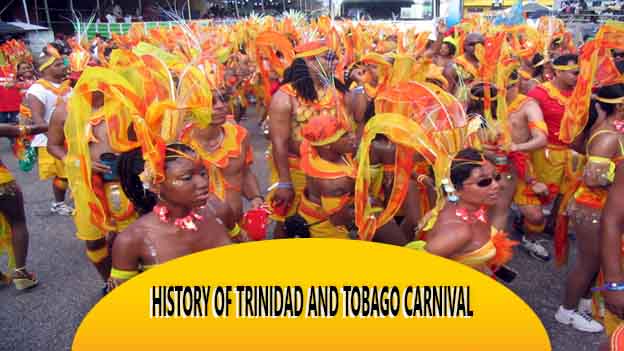History Of Trinidad And Tobago Carnival: Trinidad and Tobago Carnival is a vibrant and colorful festival celebrated on the twin-island nation of Trinidad and Tobago in the Caribbean. It is a cultural extravaganza that showcases the rich heritage and diversity of the nation. In this article, we will take a journey through the history of this iconic event, tracing its roots to the present-day grand celebrations.
- The Origins of Carnival
- The Influence of African Traditions
- The Impact of Indentured Labor
- Suppression and Resurgence
- The Birth of Steel Pans
- Modern-Day Carnival
- The Role of Calypso and Soca Music
- The Impact of Tourism
- The Queen and King of Carnival
- The Future of Trinidad and Tobago Carnival
- Conclusion
- FAQs: History Of Trinidad And Tobago Carnival
The Origins of Carnival
The origins of Trinidad and Tobago Carnival can be traced back to the 18th century when French settlers brought the tradition of celebrating Carnival to the islands. The festival was initially a pre-Lenten event, filled with feasting, music, dance, and masquerade. It was a way for the slaves to celebrate their culture and traditions despite their oppressive circumstances.
The Influence of African Traditions
As the Carnival evolved over the years, it assimilated African cultural elements, reflecting the significant influence of African slaves in Trinidad and Tobago. African traditions like drumming, vibrant costumes, and storytelling became integral parts of the festivities, adding a unique flavor to the celebrations. History Of Trinidad And Tobago Carnival.
The Impact of Indentured Labor
In the 19th century, after the abolition of slavery, Trinidad and Tobago experienced an influx of indentured laborers from India. With their arrival, the Carnival saw yet another transformation, incorporating Indian traditions such as the “tassa” drumming and mesmerizing Bollywood-inspired dance performances.
Suppression and Resurgence
During the colonial era, authorities attempted to suppress the Carnival, fearing its potential for rebellion and resistance. However, the resilient spirit of the Trinbagonian people prevailed, and the Carnival experienced a resurgence in the early 20th century.
- Also Read:
The Birth of Steel Pans
One of the most significant contributions of Trinidad and Tobago to the world of music came with the invention of the steel pan. Created in the impoverished neighborhoods of Port of Spain, steel pans quickly became an integral part of the Carnival, producing vibrant and melodious sounds that captivated audiences worldwide.
Modern-Day Carnival
In the modern era, Trinidad and Tobago Carnival has evolved into a two-day event, with Monday designated as “J’Ouvert,” a pre-dawn celebration filled with paint, mud, and revelry. The main parade takes place on Tuesday, where bands showcase their elaborate and breathtaking costumes, dancing to the infectious rhythms of calypso and soca music.
The Role of Calypso and Soca Music
Calypso and soca music play a crucial role in the Carnival, serving as the heartbeat of the festivities. Calypso, known for its witty and often satirical lyrics, was traditionally used by slaves to communicate their grievances and mock their masters. Soca, a more contemporary genre, brings a vibrant energy to the celebrations, encouraging everyone to dance and celebrate.
The Impact of Tourism
Trinidad and Tobago Carnival has become a major tourist attraction, drawing visitors from all corners of the globe. The festival’s infectious energy, dazzling costumes, and pulsating music allure travelers seeking a unique and unforgettable cultural experience.
The Queen and King of Carnival
A significant highlight of the Carnival is the crowning of the King and Queen of Carnival. These individuals are chosen for their exceptional costumes and performances, symbolizing the pinnacle of creativity and artistry in the festival.
The Future of Trinidad and Tobago Carnival
As Trinidad and Tobago Carnival continues to evolve, it faces both opportunities and challenges. Preserving its cultural authenticity while embracing contemporary trends will be vital to ensuring its longevity and relevance for generations to come.
Conclusion
History Of Trinidad And Tobago Carnival: Trinidad and Tobago Carnival is more than just a festival; it is a celebration of identity, culture, and resilience. From its humble beginnings to becoming a global phenomenon, the Carnival stands as a testament to the power of traditions and the spirit of a people. So, if you seek a carnival experience like no other, make sure to put Trinidad and Tobago Carnival on your bucket list!
FAQs: History Of Trinidad And Tobago Carnival
-
When does Trinidad and Tobago Carnival take place?
The Carnival takes place annually, culminating on the Monday and Tuesday before Ash Wednesday.
-
Are there age restrictions for participating in the festivities?
No, the Carnival welcomes participants of all ages, making it a family-friendly event.
-
How can I experience the Trinidad and Tobago Carnival like a local?
To experience the Carnival like a local, consider joining a mas band and fully immersing yourself in the revelry.
-
What is the significance of the steel pan in the Carnival?
The steel pan is a symbol of the nation’s creativity and ingenuity, having originated in Trinidad and Tobago.
-
Are there any other Carnivals celebrated around the world?
Yes, Carnivals are celebrated in various countries, with the most famous ones being in Rio de Janeiro, Brazil, and Notting Hill, London.
